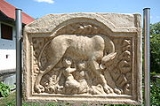
Teurnia
Encyclopedia
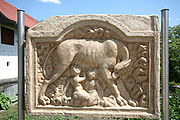
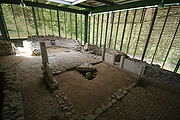
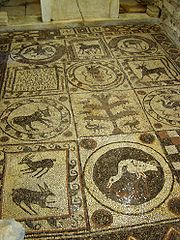
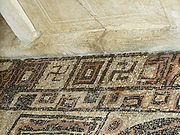

Municipium
Municipium , the prototype of English municipality, was the Latin term for a town or city. Etymologically the municipium was a social contract between municipes, the "duty holders," or citizens of the town. The duties, or munera, were a communal obligation assumed by the municipes in exchange for...
Teurnia (later also : Tiburnia) was a Roman
Roman Empire
The Roman Empire was the post-Republican period of the ancient Roman civilization, characterised by an autocratic form of government and large territorial holdings in Europe and around the Mediterranean....
city in western Carinthia
Carinthia (state)
Carinthia is the southernmost Austrian state or Land. Situated within the Eastern Alps it is chiefly noted for its mountains and lakes.The main language is German. Its regional dialects belong to the Southern Austro-Bavarian group...
. In late antiquity
Late Antiquity
Late Antiquity is a periodization used by historians to describe the time of transition from Classical Antiquity to the Middle Ages, in both mainland Europe and the Mediterranean world. Precise boundaries for the period are a matter of debate, but noted historian of the period Peter Brown proposed...
it was also a bishop's see, and towards the end of Roman times it was mentioned as the capital of the province of Noricum mediterraneum. Today Tiburnia is a titular see
Titular see
A titular see in various churches is an episcopal see of a former diocese that no longer functions, sometimes called a "dead diocese". The ordinary or hierarch of such a see may be styled a "titular bishop", "titular metropolitan", or "titular archbishop"....
of the Roman-Catholic church.
History
Ancient Teurnia was situated on a wooded hill at the village of St. Peter-in-Holz in the municipality of LendorfLendorf
Lendorf is a municipality in the district of Spittal an der Drau in the Austrian state of Carinthia. It consists of the Katastralgemeinden Lendorf and Hühnersberg....
in the Lurnfeld
Lurnfeld
Lurnfeld is a market town in the district of Spittal an der Drau in the Austrian state of Carinthia. The municipality consists of the two Katastralgemeinden Möllbrücke and Pusarnitz....
valley, four kilometres to the west of Spittal an der Drau
Spittal an der Drau
Spittal an der Drau is located in the western part of the Austrian federal state of Carinthia and the administrative centre of the federal state's second largest district, Spittal an der Drau. It lies between the Lurnfeld area and the Lower Drava Valley. The city consists of the seven...
in Upper (i.e. western) Carinthia, Austria. As early as 1100 B.C. people had lived there on Holzerberg hill, which may well have also seen the centre of the Celtic Taurisci
Taurisci
The Taurisci were a federation of Celtic tribes who dwelt in today's northern Slovenia before the coming of the Romans According to Pliny the Elder, they are the same people known as the Norici...
nation before c. 50 A.D. the Roman town was built with a forum
Forum (Roman)
A forum was a public square in a Roman municipium, or any civitas, reserved primarily for the vending of goods; i.e., a marketplace, along with the buildings used for shops and the stoas used for open stalls...
, a market basilica
Basilica
The Latin word basilica , was originally used to describe a Roman public building, usually located in the forum of a Roman town. Public basilicas began to appear in Hellenistic cities in the 2nd century BC.The term was also applied to buildings used for religious purposes...
, a temple on the city's Capitol, Thermae
Thermae
In ancient Rome, thermae and balnea were facilities for bathing...
or public baths, terraced housing on two terraces , and a temple dedicated to Grannus
Grannus
In the Celtic polytheism of classical antiquity, Grannus was a deity associated with spas, healing thermal and mineral springs, and the sun. He was regularly identified with Apollo as Apollo Grannus...
, the Celt
Celt
The Celts were a diverse group of tribal societies in Iron Age and Roman-era Europe who spoke Celtic languages.The earliest archaeological culture commonly accepted as Celtic, or rather Proto-Celtic, was the central European Hallstatt culture , named for the rich grave finds in Hallstatt, Austria....
ic counterpart deity of Aesculap
Asclepius
Asclepius is the God of Medicine and Healing in ancient Greek religion. Asclepius represents the healing aspect of the medical arts; his daughters are Hygieia , Iaso , Aceso , Aglæa/Ægle , and Panacea...
, god of medicine and healing, but in Teurnia invoked as Grannus Apollo. Usually older hill-top settlements were moved by the Romans to lower-lying areas with the one exception of the oppidum at Teurnia in the tribal region of the Ambidravi, where old names are said to have been retained and no renaming took place.
Teurnia was one of the largest places in all Noricum
Noricum
Noricum, in ancient geography, was a Celtic kingdom stretching over the area of today's Austria and a part of Slovenia. It became a province of the Roman Empire...
with, in its peak period, a population of 30,000. Towards the end of the Empire the population decreased; people left the housing terraces, and the slopes being no longer suitable for agriculture were used as cemeteries. At the same time walls went up surrounding the hilltop with material from the deserted houses.
By the 4th century Teurnia was already a Christian town and was a bishop's see until the city's decline and its end in 610
610
Year 610 was a common year starting on Thursday of the Julian calendar. The denomination 610 for this year has been used since the early medieval period, when the Anno Domini calendar era became the prevalent method in Europe for naming years...
. From the vita Severini by Eugippius
Eugippius
Eugippius was a disciple and the biographer of Saint Severinus of Noricum. After the latter's death in 492, he took the remains to Naples and founded a monastery on the site of a 1st century Roman villa, the Castellum Lucullanum .While at Naples, Eugippius compiled a 1000-page anthology of the...
of the year 511 A.D. we learn that Severinus, the “apostle to Noricum”, was in contact with a bishop of Tiburnia/Teurnia by the name of Paulinus
Paulinus
Paulinus/Paullinus is a Roman cognomen that can refer to:*Gaius Suetonius Paulinus, general who defeated BoudicaRoman consuls*Marcus Iunius Caesonius Nicomachus Anicius Faustus Paulinus, consul in 298...
. From the fact that said Paulinus wrote admonishing letters to the communities of his see we may assume that he was the metropolitan bishop
Metropolitan bishop
In Christian churches with episcopal polity, the rank of metropolitan bishop, or simply metropolitan, pertains to the diocesan bishop or archbishop of a metropolis; that is, the chief city of a historical Roman province, ecclesiastical province, or regional capital.Before the establishment of...
of the province. Thus Teurnia may well be presumed to have truly succeeded Virunum
Virunum
Claudium Virunum was a Roman city in the province of Noricum, on today's Zollfeld in the Austrian State of Carinthia. Virunum may also have been the name of the older Celtic-Roman settlement on the hilltop of Magdalensberg nearby....
as the provincial capital city in the Migration Period
Migration Period
The Migration Period, also called the Barbarian Invasions , was a period of intensified human migration in Europe that occurred from c. 400 to 800 CE. This period marked the transition from Late Antiquity to the Early Middle Ages...
. The last mention of the city and diocese of Tiburnia is from 591 in a letter of the Venetic
Adriatic Veneti
The Veneti were an ancient people who inhabited north-eastern Italy, in an area corresponding to the modern-day region of the Veneto....
and Rhaetic
Raetia
Raetia was a province of the Roman Empire, named after the Rhaetian people. It was bounded on the west by the country of the Helvetii, on the east by Noricum, on the north by Vindelicia, on the west by Cisalpine Gaul and on south by Venetia et Histria...
bishops.
Excavations
Holzerberg hill was a well-known place of antique finds as early as the Middle AgesMiddle Ages
The Middle Ages is a periodization of European history from the 5th century to the 15th century. The Middle Ages follows the fall of the Western Roman Empire in 476 and precedes the Early Modern Era. It is the middle period of a three-period division of Western history: Classic, Medieval and Modern...
. Many spolia
Spolia
Spolia is a modern art-historical term used to describe the re-use of earlier building material or decorative sculpture on new monuments...
s of buildings in the area come from here. Interest in the Roman finds increased duríng and after the Renaissance
Renaissance
The Renaissance was a cultural movement that spanned roughly the 14th to the 17th century, beginning in Italy in the Late Middle Ages and later spreading to the rest of Europe. The term is also used more loosely to refer to the historical era, but since the changes of the Renaissance were not...
, but it took a long time until the ruins were identified as the city of Teurnia or Tiburnia known from antique sources. Professional excavations began with the accidental discovery of the cemetery church in 1908. The mosaic of its donor, the praeses
Praeses
Praeses , is a Latin word meaning "Seated in front of, i.e. at the head ", has both ancient and modern uses.-Roman imperial use:...
or governor Ursus, in the right side-chapel of the three-naved basilica
Basilica
The Latin word basilica , was originally used to describe a Roman public building, usually located in the forum of a Roman town. Public basilicas began to appear in Hellenistic cities in the 2nd century BC.The term was also applied to buildings used for religious purposes...
is in near-perfect preservation. In twelve pictures the mosaic shows christological, mythological and biblical symbols as well as the names of one Ursus, the donor, and his spouse, Ursina.
In 1984 the Early-Christian
Early Christianity
Early Christianity is generally considered as Christianity before 325. The New Testament's Book of Acts and Epistle to the Galatians records that the first Christian community was centered in Jerusalem and its leaders included James, Peter and John....
bishop's church was discovered, which has now been roofed over and is open to visitors. The church walls have been preserved up to a height of six feet and show mural paintings. Excavations were also made along the southern side of the church, where a marble tablet and parts of a cross were unearthed. Earlier guesses had been that the bishop's church was beneath today's parish church, but from historic comparisons Franz Glaser, who is in charge of the Teurnia excavations, deducted the actual position along the western city walls. The episcopal church was built at the beginning of the fifth century and a century later, after a destructive fire, was rebuilt in basilica
Basilica
The Latin word basilica , was originally used to describe a Roman public building, usually located in the forum of a Roman town. Public basilicas began to appear in Hellenistic cities in the 2nd century BC.The term was also applied to buildings used for religious purposes...
style with three naves and three apses
Apsis
An apsis , plural apsides , is the point of greatest or least distance of a body from one of the foci of its elliptical orbit. In modern celestial mechanics this focus is also the center of attraction, which is usually the center of mass of the system...
. In analogy to the Hemmaberg situation in Lower (i.e. eastern) Carinthia, here too the bishop's church might have served the Catholic community, whereas Arian
Arianism
Arianism is the theological teaching attributed to Arius , a Christian presbyter from Alexandria, Egypt, concerning the relationship of the entities of the Trinity and the precise nature of the Son of God as being a subordinate entity to God the Father...
s used the cemetery church for their services.
In the village centre of St. Peter-in-Holz there is a recent “Römer-Museum” exhibiting numerous artefacts from the city area of Teurnia. Nearby are the preserved remains of a Roman town villa
Roman villa
A Roman villa is a villa that was built or lived in during the Roman republic and the Roman Empire. A villa was originally a Roman country house built for the upper class...
or villa urbana boasting a simple hypocaust
Hypocaust
A hypocaust was an ancient Roman system of underfloor heating, used to heat houses with hot air. The word derives from the Ancient Greek hypo meaning "under" and caust-, meaning "burnt"...
in form of the letter Y. Next to the bishop's church the Hospitium
Hospitium
Hospitium , hospitality, among the Greeks and Romans, was of a twofold character: private and public.-Private:In Homeric times all strangers without exception, were regarded as being under the protection of Zeus Xenios, the god of strangers and suppliants...
, the bishop's guest house, was found, but for protection purposes it has been covered with soil again. More excavation work is going on. Information on the city's history and the excavation work is provided in display cases all over the area.
Titular Bishops and Archbishops
- Emilio Benavent EscuínEmilio Benavent EscuínEmilio Benavent Escuín was a Spanish Bishop of the Roman Catholic Church.Escuín was born in Valencia, Spain and was ordained a priest on July 18, 1943. He was appointed to Auxiliary bishop of the Diocese of Málaga as well as Titular Bishop of Cercina on December 6, 1954, and was ordained a bishop...
, Titular Archbishop of Tiburnia, 26 August 1968 – 3 February 1974 - Donato SquicciariniDonato SquicciariniDonato Squicciarini was an Italian Catholic archbishop who acted as Nuncio to Austria from 1989 to 2002.Squicciarini was born at Altamura, Apulia on 24 April 1927. He was ordained priest 12 April 1952, and was appointed Titular Archbishop of Tiburnia and Apostolic Nuncio to Burundi on 26 November...
, Titular Archbishop of Tiburnia 31 August 1978 – 5 March 2006 - Víctor René Rodríguez Gómez, Titular Bishop of Tiburnia since 13 May 2006; born 17 Nov 1950 in San Martín de las PirámidesSan Martín de las PirámidesSan Martín de las Pirámides is a small town and municipality, in Mexico State in Mexico. The municipality covers an area of 70 km².As of 2005, the municipality had a total population of 21,511....
; appointed Titular Bishop of Tiburnia and Auxiliary Bishop of TexcocoRoman Catholic Diocese of TexcocoThe Roman Catholic Diocese of Texcoco is a suffragan diocese of the Archdiocese of Tlalnepantla.-Ordinaries:*Francisco Ferreira Arreola *Magín Camerino Torreblanca Reyes...
, 13 May 2006; ordained Bishop of Tiburnia 25 July 2006.
Literature
- Barley, Maurice Willmore,European towns: their archaeology and early history. Published for the Council for British Archaeology. New York: Academic Press, 1977 ISBN 0-12-078850-0
- Glaser, Franz, Teurnia: Römerstadt und Bischofssitz Klagenfurt: Verlag des Geschichtsvereins 1992 (German)
- Glaser, Franz, Frühchristliche Denkmäler in Kärnten, Klagenfurt: Verlag des Geschichtsvereins 1996 (German)
- Glaser, Franz, Römermuseum Teurnia - Texte und Zeichnungen, Klagenfurt: Verlag des Geschichtsvereins 2002 (German)
- Gugl, Christian, Archäologische Forschungen in Teurnia: die Ausgrabungen in den Wohnterrassen 1971-1978 : die latènezeitlichen Funde vom Holzer Berg, Vienna: Österreichisches Archäologisches Institut, 2000(German)
- Gugl, Christian, Das Umland Teurnias vom 2. Jahrhundert v. Chr. bis ins 1. Jahrhundert n.Chr. Eine Studie zur Siedlungskontinuität von der Latène- zur Römerzeit im oberen Drautal.In: Arheološki Vestnik (ACTA ARCHAEOLOGICA) 52 (2001) Ljubljana: Slovenska akademija 2001, pp. 303–349 ISSN 0-570-8966 English Abstract
- Michael Doneus,Precision mapping and interpretation of oblique aerial photographs (= Archaeological Prospection Vol.8, Issue 1) Hoboken NJ: John Wiley & Sons, 2001 pp. 13 – 27,
- Kos,Marjeta Šašel, Pre-Roman divinities of the eastern Alps and Adriatic, Ljubljana: Narodni muzej Slovenije, 1999, ISBN 961-6169-11-4
External links
- Map and description of Teurnia
- Carinthian State Museum: Description and pictures(German)
- List of all Titular sees by Giga-Catholic Information
- List of titular sees
- Titular see (Archdiocese) of Tiburnia

